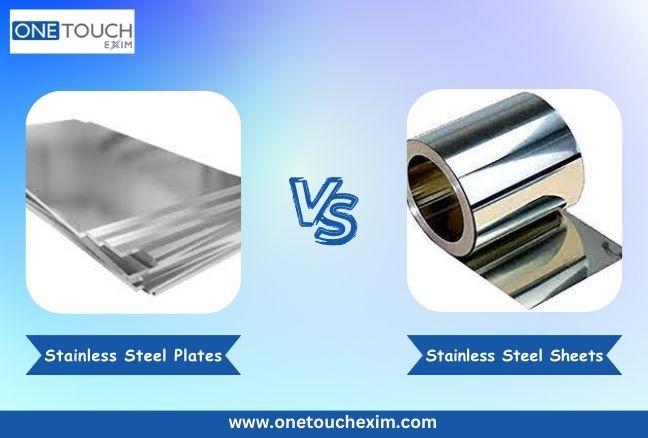The most valuable difference between plate and sheet is the thickness with plate being thicker than sheet.
Stainless steel sheet :- Sheet metal may be between 3 and 7 mm thick. Stainless Steel Sheet ranges in thickness from 6 to 2 mm. It is highly formable and used to fabricate items such as appliance exteriors, automotive trim, pots and pans, kitchen sinks and marine equipment.
Stainless steel plate :- Stainless plate is thicker, at 3/16 thick and above. It is strong, stiff and is also used as a material for construction like building and bridges; ships; vehicles(car, truck, bicycles); machines; appliances; tools and weapons to name just a few high-stress applications.
What is Stainless Steel?
An iron alloy, stainless steel has a minimum of 10.5% chromium. This chromium produces a very thin and invisible (only microscopically small) layer of oxide. It is this which prevents rust from perforating the iron.
Other things like nickel (making it more ductile and less prone to corrosion), molybdenum (resisting pitting) or carbon (upping the strength) are thrown in for certain properties. Its strength, hygienic qualities, ease of cleaning and attractiveness make it ideal for many applications such as cookware products, architecture, medical instruments, chemical processing and food handling equipment.
What is a Stainless Steel Plate?
A stainless steel plate is a flat rolled product that is 3/16 inch thicker, whereas a sheet with a thinner thickness is referred to as foil. This heavyweight gauge construction is strong and durable with a load rating of 110 lbs. Impact resistance from moving steel wheels won’t defeat these panels.
It is made from a variety of stainless steel types (including 304 and 316). It is also suitable for heavy duty industrial use and long life where resilient construction is required. This covers the use of it in construction, ship building and other pressure vessels, large equipment of industrial flooring and structural components under high stress and harsh environments.
Applications of Stainless Steel Plate
- Construction & Architecture :- It’s a go to material for structural support frames, building facades and new age architectural cladding because of its strength and good looks.
- Industrial Processing :- Flexicon Tubing is corrosion-resistant. It is widely used to transport chemicals in the chemical tanks, pressure vessels and piping systems.
- Transportation :- Made into ship hulls, shipping containers and railcars to provide resistance in even the most punishing conditions.
- Energy Industry :- Essential to nuclear, oil and gas installations. Containment structures and components that must withstand high pressure at high temperature.
What is a Stainless Steel Sheet?
A Stainless Steel sheet is a flat, thin section with square or rectangular shape made directly from an intermediate hot rolling slab or billet and produced for commercial working. Its less than 90 degree angle allows infinite positions as with all drill bases,
Produced from anti-rust material such as Grade 304 or 316, it is hygienic, clean and robust. Applications include kitchen equipment, household appliances, sinks and splashbacks in the food industry, chemical plants and automotive trim. It is the perfect choice for projects that need a combination of corrosion resistance and the ability to be turned or shaped into specific forms.
Applications of Stainless Steel Sheet
- Appliances Industry :- Being used for two plates of the stove to keep the pots stable(combining with graphite) and electric SAS. Colour with redrawing wire mesh.
- Food Service & Processing :- This work table can be used in commercial places for storing /preparing food, baking and many more.
- Architectural Cladding :- A versatile, modern way to decorate a room or an exterior.
- Automotive & Transportation :- Used for automotive trim, grills and exhaust systems as well as in decorative panels.
- Consumer Goods :- For use in kitchen sinks, back splashes, cookware and residential appliances for its corrosion resistance and aesthetic appearance.
Advantages of Stainless Steel Plate and Sheet
Stainless Steel Plates and Sheets are the most popular board used to provide protection for the target due to its high corrosion resistance that is durable while facing the harshest environment. They have metallic high strength and durability, plates performing structural loading at very low temperatures and sheets being utilized in products formed from jig welded applications. Both are sanitary and easy to clean which is ideal for food, medical and chemical applications. They are beautiful materials that provide a contemporary, streamlined look to an architectural project. They also provide heat and chemical resistance, are 100% recyclable and require minimum maintenance while delivering revolutionary value and performance for industrial, commercial, automotive and consumer applications.
Conclusion
The difference between stainless steel sheet and plates is size, thickness and grade. Plates – sheets are thicker, heavier and ensure better durability for highly demanding industrial as well as commercial purposes. Thinner sheet is also easier to form into desired shapes for applications such as appliances, automotive parts and architectural cladding where shaping and fabrication are needed. Each possesses the same corrosion resistant and durable qualities of the material.
